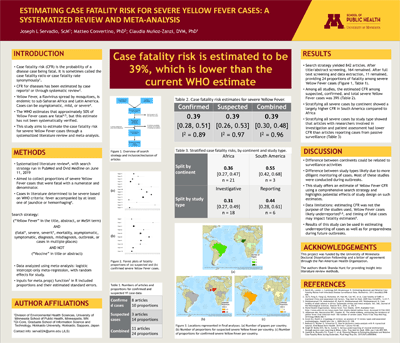Joseph Servadio
PhD, Environmental Health
Co-Authors:
Matteo Convertino, Claudia Muñoz-Zanzi
Advisor:
Dr. Matteo Convertino
Educational Objectives:
- Define case fatality risk
- Identify the steps in a comprehensive literature review
- Assess the possible sources of heterogeneity among stratified case fatality ratios
Keywords:
Case fatality risk, Yellow Fever
Abstract
Case fatality risk (CFR), commonly referred to as a case fatality ratio or case fatality rate, represents the probability of a disease case being fatal. It is often estimated for various diseases through case reports, record examination, or literature review. The WHO reports that the CFR for severe Yellow Fever cases is approximately 50%. Yellow Fever is a mosquito-borne febrile disease with a subset of cases classified as severe, identified by symptoms of fever with jaundice and/or hemorrhaging. This fatality risk has not been estimated or updated via a comprehensive review of literature. This study aims to estimate the case fatality risk of severe Yellow Fever cases through a systematized literature review and meta-analysis. A search strategy was implemented in PubMed and Ovid Medline in June 2019, seeking reported severe case counts and the number of those that were fatal. The search yielded 842 studies, and title/abstract review followed by full text review produced 11 articles reporting 24 proportions of fatal cases. Data were analyzed through an intercept-only logistic meta regression with random effects for study. The estimated CFR was 0.39 (95% CI: [30, 48]). Stratifying by continent and by study type showed that South America observes a higher CFR than Africa, and studies reporting surveillance observe higher CFR than studies investigating outbreaks. This study provides the first comprehensive literature review to estimate the CFR of Yellow Fever, which can provide insight into outbreak preparedness and quantification of underreporting.
Support
This work is supported by the University of Minnesota Doctoral Dissertation Fellowship as well as a letter of agreement with the Pan American Health Organization.

View Poster (PDF)
